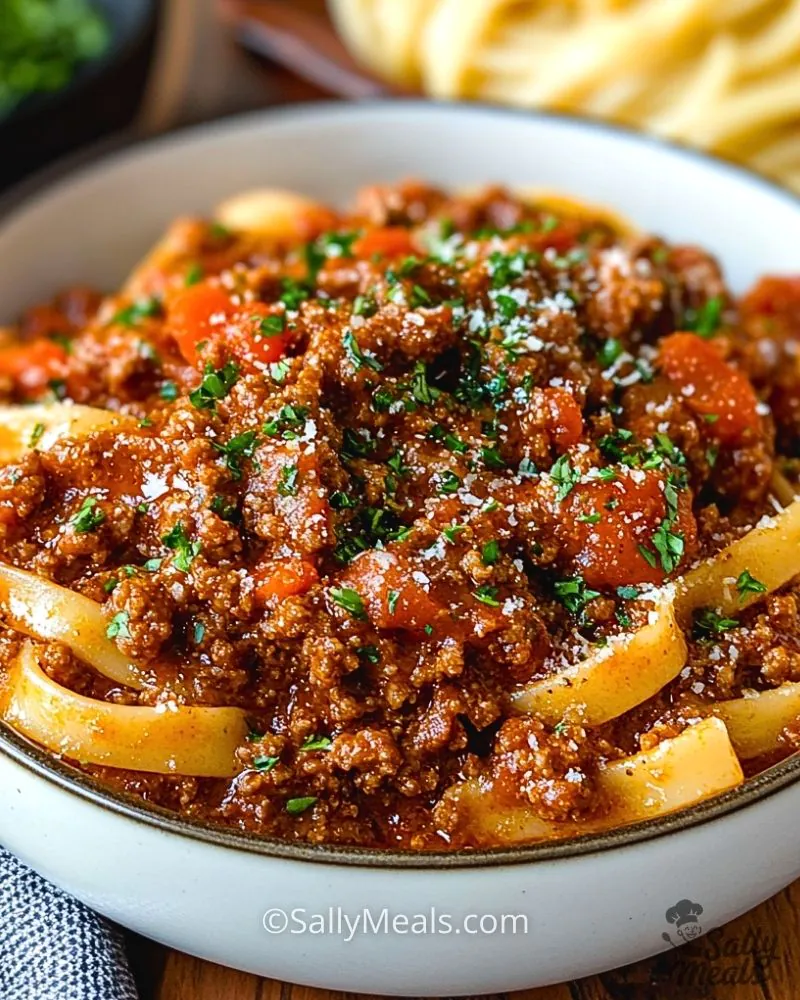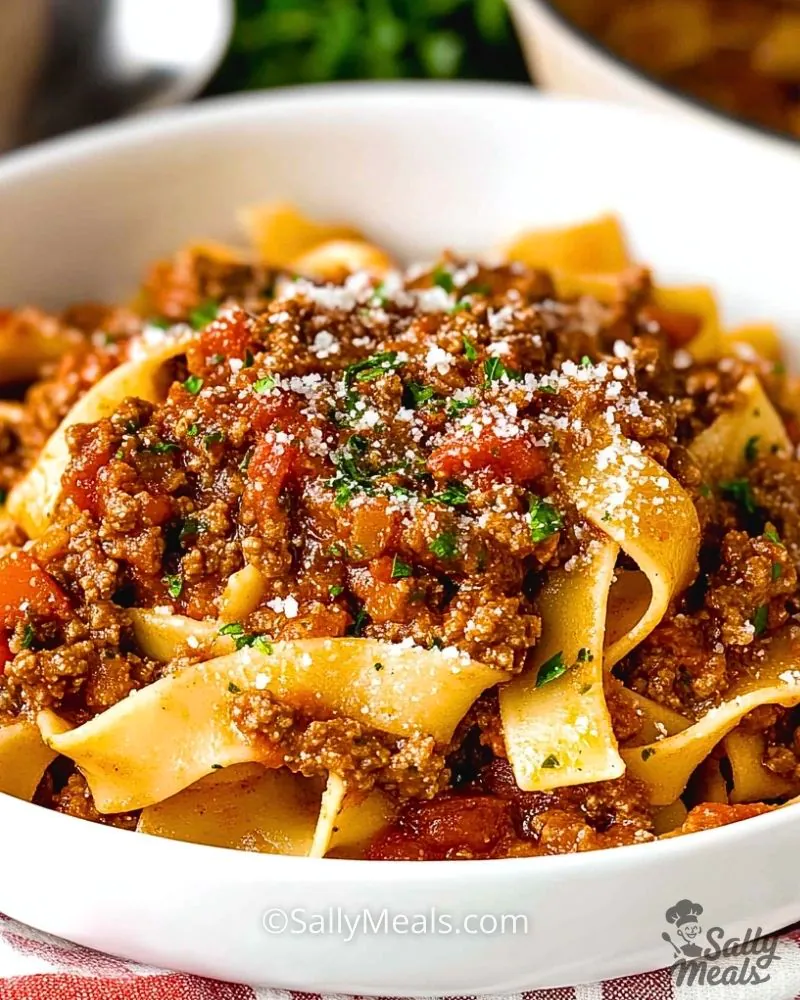A rich, slow-simmered Bolognese sauce is the heart of true Italian comfort food. This dish combines tender ground beef, aromatic vegetables, and a deep, flavorful tomato base that develops over time. The result is a luscious, meaty sauce that clings beautifully to pasta, creating a meal that’s both hearty and satisfying. Whether you’re making it for a family dinner or a special occasion, this sauce brings warmth and tradition to the table.

Unlike a simple marinara, Bolognese is a slow-cooked labor of love, allowing layers of flavor to build over time. The addition of wine, milk, and a blend of herbs gives it a complex depth that sets it apart from other pasta sauces. Served over pappardelle, tagliatelle, or even a classic spaghetti, this dish is a staple in Italian cuisine that never goes out of style.
Why You’ll Love This Homemade Bolognese Sauce
- Deep, rich flavor – The slow simmering process enhances the depth of taste, making every bite incredibly satisfying.
- Authentic Italian experience – This sauce follows the traditional techniques of Italian cooking, ensuring an authentic taste.
- Versatile and hearty – Perfect for pasta, lasagna, or even as a filling for stuffed vegetables.
- Meal prep-friendly – Freezes and stores well, making it ideal for batch cooking.
- Comfort food at its best – A warm, homemade meal that feels like a hug in a bowl.
Preparation Phase & Tools to Use
Making homemade Bolognese sauce requires a few essential tools to ensure the process is smooth and efficient. Here’s what you’ll need:
- Large Dutch Oven or Heavy-Bottomed Pot – A thick, heavy pot helps evenly distribute heat and prevents the sauce from burning during its long simmer.
- Wooden Spoon or Silicone Spatula – Essential for stirring and breaking up the meat while cooking. A wooden spoon is great for scraping up flavorful browned bits from the bottom of the pot.
- Sharp Chef’s Knife and Cutting Board – Prepping the aromatics like onions, carrots, and celery requires a reliable, sharp knife for precise chopping.
- Measuring Cups and Spoons – Accuracy matters when balancing the flavors of tomatoes, wine, and seasonings.
- Ladle – Makes it easy to serve and portion the sauce without making a mess.
Having these tools ready ensures that cooking your Bolognese sauce is effortless and enjoyable.
Preparation Tips
- Mince the vegetables finely – A finely chopped soffritto (onions, carrots, celery) melds seamlessly into the sauce, giving it a rich base without large chunks.
- Use a mix of meats – Combining ground beef and pork enhances the flavor, adding depth and tenderness.
- Brown the meat properly – Let the meat develop a nice sear before breaking it apart, as this adds a deep, savory taste to the sauce.
- Deglaze with wine – This step lifts the browned bits from the pot, infusing the sauce with extra layers of flavor.
- Simmer low and slow – The longer the sauce cooks, the richer and thicker it becomes. Aim for at least 2-3 hours for best results.
- Add milk for creaminess – This might sound unusual, but milk helps tenderize the meat and balances the acidity of the tomatoes.
These tips ensure that your Bolognese turns out rich, flavorful, and restaurant-quality every time.
Ingredients for This Homemade Bolognese Sauce
To make a rich and authentic Bolognese sauce, you’ll need a combination of fresh ingredients and pantry staples. Here’s what you’ll need:
Meat and Dairy:
- 1 lb (450g) ground beef (or a mix of beef and pork for extra flavor)
- ½ cup whole milk (to tenderize the meat and balance acidity)
- 2 tbsp unsalted butter (for richness)
Aromatics and Vegetables:
- 1 small onion, finely chopped
- 1 carrot, finely diced
- 1 celery stalk, finely diced
- 3 cloves garlic, minced
Liquids and Seasonings:
- ½ cup dry red wine (for depth and richness)
- 1 can (28 oz) crushed tomatoes
- 2 tbsp tomato paste (adds concentrated tomato flavor)
- 1 cup beef broth (for added depth)
- 1 tsp dried oregano
- 1 tsp dried basil
- 1 bay leaf
- Salt and black pepper to taste
- ¼ tsp red pepper flakes (optional, for a little heat)
Finishing Touches:
- ¼ cup grated Parmesan cheese (for serving)
- Fresh parsley or basil, chopped (for garnish)
- Cooked pappardelle, tagliatelle, or spaghetti
These ingredients come together to create a deeply flavorful sauce that clings perfectly to your pasta. The combination of aromatics, slow-cooked meat, and rich tomato base ensures an unforgettable homemade Bolognese experience.

Step 1: Prepare the Ingredients
Start by finely chopping the onion, carrot, and celery. Mince the garlic and set everything aside. Measure out the liquids, seasonings, and other ingredients so they are ready to use.
Step 2: Sauté the Aromatics
In a large Dutch oven or heavy-bottomed pot, melt the butter over medium heat. Add the chopped onion, carrot, and celery, and cook for about 5 minutes until softened. Stir in the minced garlic and cook for another minute until fragrant.
Step 3: Brown the Meat
Add the ground beef (or beef and pork mix) to the pot. Use a wooden spoon to break it apart, and let it brown evenly. Cook for about 7–10 minutes until the meat is fully cooked and slightly caramelized.
Step 4: Deglaze with Wine
Pour in the red wine and stir well, scraping up any browned bits from the bottom of the pot. Let it simmer for 2–3 minutes until the alcohol cooks off and the liquid slightly reduces.
Step 5: Add Tomatoes and Seasonings
Stir in the tomato paste, crushed tomatoes, beef broth, oregano, basil, bay leaf, salt, black pepper, and red pepper flakes (if using). Mix well to combine all the flavors.
Step 6: Simmer Low and Slow
Reduce the heat to low and let the sauce simmer uncovered for at least 2–3 hours. Stir occasionally, allowing the flavors to develop and the sauce to thicken.
Step 7: Add Milk for Creaminess
About 30 minutes before the sauce is done, stir in the milk. This helps tenderize the meat and balance the acidity of the tomatoes. Let it continue simmering.
Step 8: Final Adjustments and Serving
Taste the sauce and adjust seasoning if needed. Remove the bay leaf. Serve over cooked pappardelle, tagliatelle, or spaghetti, and top with freshly grated Parmesan and chopped parsley or basil.
Notes
- Simmering is key – Bolognese sauce develops its deep, rich flavor over time. A slow simmer for at least 2–3 hours is essential for the best taste and texture.
- Use quality ingredients – Since this is a simple sauce, high-quality tomatoes, fresh vegetables, and good ground meat will make a noticeable difference.
- Wine choice matters – A dry red wine like Chianti, Merlot, or Cabernet Sauvignon adds depth to the sauce. If you don’t want to use wine, substitute it with additional beef broth.
- Milk is a secret weapon – It may seem unusual, but milk helps balance the acidity of tomatoes and tenderizes the meat, giving the sauce a velvety texture.
- Make it ahead – This sauce tastes even better the next day as the flavors continue to meld.
Watch Out for These Mistakes While Cooking
1. Rushing the Simmering Process
Bolognese sauce needs time to develop its deep, rich taste. A quick 30-minute cook won’t do it justice—give it at least 2–3 hours.
2. Using Lean Meat Only
Fat adds flavor! If you use lean meat, the sauce may lack richness. Opt for a mix of beef and pork, or use beef with at least 15–20% fat content.
3. Skipping the Wine or Not Cooking It Off Properly
Wine enhances the sauce, but it needs to be cooked down properly to remove the alcohol and concentrate the flavor.
4. Not Chopping the Vegetables Finely
Large chunks of vegetables won’t blend well into the sauce. Take your time to dice them finely for a smooth and well-balanced texture.
5. Adding Too Many Herbs Too Soon
Dried herbs should be added early, but fresh herbs like basil should be added at the end to maintain their fresh taste.
6. Overcrowding the Pan When Browning Meat
If you add too much meat at once, it will steam instead of browning properly. Cook in batches if necessary.
7. Forgetting to Taste and Adjust Seasoning
As the sauce simmers, flavors concentrate. Always taste before serving and adjust salt, pepper, or acidity as needed.
8. Not Removing the Bay Leaf
Bay leaves add subtle depth to the sauce but are not meant to be eaten. Don’t forget to take them out before serving!
What to Serve With Homemade Bolognese Sauce?
A rich, hearty Bolognese sauce pairs beautifully with a variety of sides and accompaniments. Whether you want a full Italian feast or just a simple complement, here are some great options:
8 Recommended Pairings
1. Pappardelle or Tagliatelle
These wide, ribbon-like pastas are the best match for Bolognese because they hold onto the thick, meaty sauce perfectly.
2. Garlic Bread
Crispy, buttery, and infused with garlic, this classic side is perfect for scooping up every last bit of sauce.
3. Parmesan Roasted Vegetables
Roasting vegetables like zucchini, bell peppers, or asparagus with Parmesan and olive oil adds a delicious, slightly crispy contrast to the saucy pasta.
4. Classic Caesar Salad
A fresh, crunchy salad with creamy dressing and Parmesan shavings balances out the richness of the Bolognese.
5. Polenta
Creamy polenta serves as a hearty, comforting base that soaks up the deep flavors of the sauce beautifully.
6. Burrata or Caprese Salad
A light and refreshing mix of tomatoes, mozzarella (or burrata), basil, and balsamic glaze pairs well with the richness of the Bolognese.
7. Italian Red Wine
A glass of Chianti, Sangiovese, or Barolo enhances the flavors of the sauce and makes for an authentic Italian dining experience.
8. Crusty Artisan Bread
A warm, crusty loaf of Italian or sourdough bread is perfect for mopping up every drop of sauce.
With these sides, your homemade Bolognese sauce transforms into a complete and satisfying meal!
Storage Instructions
Bolognese sauce stores exceptionally well, making it perfect for meal prep or leftovers. Here’s how to keep it fresh:
Refrigeration
- Allow the sauce to cool completely before storing.
- Transfer it to an airtight container and refrigerate for up to 4–5 days.
- Reheat on the stove over low heat, adding a splash of water or broth if needed to loosen the sauce.
Freezing
- Let the sauce cool completely, then portion it into freezer-safe bags or containers.
- Freeze for up to 3 months.
- To thaw, place the sauce in the refrigerator overnight or reheat directly from frozen on the stove over low heat.
Pro Tip: If freezing, store in smaller portions for easy reheating and portion control.
Estimated Nutrition (Per Serving)
This is an approximate nutrition breakdown per serving of Bolognese sauce (without pasta):
- Calories: 320
- Protein: 22g
- Carbohydrates: 12g
- Fat: 20g
- Saturated Fat: 7g
- Fiber: 3g
- Sugar: 7g
- Sodium: 680mg
Nutritional values may vary depending on the type of meat and ingredients used.
Frequently Asked Questions
1. Can I make Bolognese without wine?
Yes! You can substitute the wine with extra beef broth or a splash of balsamic vinegar for added depth of flavor.
2. How long should I simmer Bolognese sauce?
For the best flavor, let it simmer for at least 2–3 hours. The longer it cooks, the richer and deeper the flavor will be.
3. Can I use ground turkey or chicken instead of beef?
Yes, but the sauce will have a lighter taste. Adding a bit of olive oil or butter can help replace the richness of beef or pork.
4. What’s the best pasta for Bolognese sauce?
Pappardelle, tagliatelle, or fettuccine are best because their wide, flat shape holds the sauce well. Spaghetti also works as a classic choice.
5. Why add milk to Bolognese sauce?
Milk helps tenderize the meat and balances the acidity of the tomatoes, giving the sauce a smooth, velvety texture.
6. Can I make this sauce ahead of time?
Absolutely! In fact, Bolognese tastes even better the next day as the flavors continue to develop.
7. How do I thicken Bolognese sauce if it’s too thin?
Let it simmer uncovered for longer, or add a small amount of tomato paste to thicken it up.
8. Can I use fresh tomatoes instead of canned?
Yes, but they need to be peeled, seeded, and cooked down to achieve the right consistency. Using high-quality canned tomatoes is an easier alternative.
Conclusion
Homemade Bolognese sauce is the ultimate Italian comfort dish—rich, hearty, and packed with deep flavors. Whether served over pasta, layered in lasagna, or stored for future meals, this sauce is a staple recipe that never disappoints. With the right ingredients, patience, and a slow simmer, you’ll have a sauce that tastes like it came straight from an Italian kitchen. So grab your favorite pasta, pour a glass of wine, and enjoy a truly satisfying meal!

Homemade Bolognese Sauce
- Prep Time: 15 minutes
- Cook Time: 2 hours
- Total Time: 2 hours 15 minutes
- Yield: 6 servings 1x
Description
A rich and hearty Italian meat sauce made with slow-simmered ground beef, aromatic vegetables, tomatoes, and a touch of milk for creaminess. Perfect for pairing with pappardelle, tagliatelle, or your favorite pasta.
Ingredients
- 1 lb (450g) ground beef (or a mix of beef and pork)
- 1 small onion, finely chopped
- 1 carrot, finely diced
- 1 celery stalk, finely diced
- 3 cloves garlic, minced
- 2 tbsp unsalted butter
- 1/2 cup dry red wine
- 1 can (28 oz) crushed tomatoes
- 2 tbsp tomato paste
- 1 cup beef broth
- 1 tsp dried oregano
- 1 tsp dried basil
- 1 bay leaf
- Salt and black pepper to taste
- 1/4 tsp red pepper flakes (optional)
- 1/2 cup whole milk
- 1/4 cup grated Parmesan cheese (for serving)
- Fresh parsley or basil, chopped (for garnish)
- Cooked pappardelle, tagliatelle, or spaghetti
Instructions
- Prepare the Ingredients – Finely chop all vegetables and measure out liquids and seasonings.
- Sauté the Aromatics – Melt butter in a large pot over medium heat. Add onion, carrot, and celery. Cook for 5 minutes until softened. Stir in garlic and cook for another minute.
- Brown the Meat – Add ground beef and cook until browned, breaking it apart with a spoon (7–10 minutes).
- Deglaze with Wine – Pour in red wine, scrape the pot’s bottom, and let it reduce for 2–3 minutes.
- Add Tomatoes and Seasonings – Stir in tomato paste, crushed tomatoes, beef broth, oregano, basil, bay leaf, salt, and pepper.
- Simmer Low and Slow – Reduce heat to low and let it simmer uncovered for at least 2–3 hours, stirring occasionally.
- Add Milk – Stir in milk 30 minutes before the sauce is done, allowing it to blend and tenderize the meat.
- Final Adjustments and Serving – Remove the bay leaf, taste and adjust seasoning, then serve over cooked pasta with Parmesan and fresh herbs.

